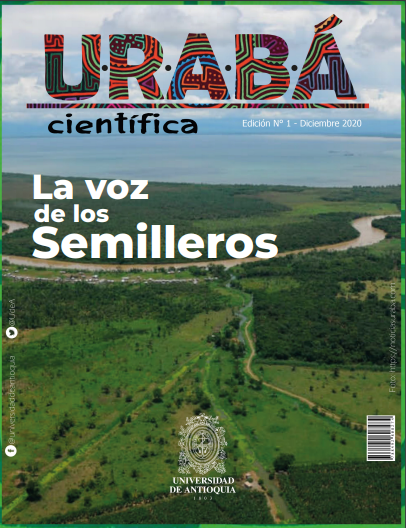Posible expansión de la especie exótica Hydroides elegans (Haswell 1883) en zonas portuarias, lagunas costeras contaminadas y otras áreas Costeras con Influencia Antropogénica directa, en el Caribe Colombiano
Palabras clave:
ecosistemas, especie, antropogénico, ambientes contaminados, artificiales costeras, ambientes naturalesResumen
In 1979 the serpulid Hydroides elegans was reported for the Colombian Caribbean though this species had already been reported there in the 1950s.
However, this species has not been included in the most recent lists of exotic or invasive marine species in Colombia. This species is widely distributed worldwide because it is tolerant to contaminated are as such as ports or coastal lagoons. H. elegans is a fouling species on the hulls of boats and this is the main vector for introduction of the species, making possible its spreading in tropical and subtropical areas. This polychaete should be included in the list of marine and coastal exotic species of the Colombian Caribbean. In addition, the vectors of introduction, the deterioration of the habitat and the specific characteristics of the species, suggest that H. elegans could be expanding in the Colombian Caribbean and, therefore, could potentially be an invasive species.
Descargas
Citas
Báez DP, Ardila NE (2003) Poliquetos ( Annelida : Polychaeta ) del Mar Caribe. Biota Colomb 4:89–109. Bastida-Zavala JR, Buelna ASR, De León-González JA, Camacho-Cruz KA, Carmona I (2016) New records of sabellids and serpulids (Polychaeta: Sabellidae, Serpulidae) from the Tropical Eastern Pacific. Zootaxa 4184:401–457.
Bastida-Zavala JR, Salazar-Vallejo SI (2000) Serpúlidos (Polychaeta: Serpulidae) del Caribe noroccidental: Hydroides y Serpula. Rev Biol Trop 48:841–858.
Bastida-Zavala R, Hove H ten (2002) Revision of Hydroides Gunnerus, 1768 (Polychaeta: Serpulidae) from the Western Atlantic Region. Beaufortia 52:103–178
Çinar ME (2013) Alien polychaete species worldwide: Current status and their impacts. J Mar Biol Assoc United Kingdom 93:1257–1278. Colautti RI, MacIsaac HI (2004) A neutral terminology to define ‘invasive’ species. Divers Distrib 10:135–141. Crooks JA, Rilov G (2009) Biological invasions in marine ecosystems: ecological,
management, and geographic perspectives, Springer. Berlin. Dean HK (2012) A literature review of the Polychaeta of the Caribbean Sea.
Didham RK, Tylianakis JM, Gemmell NJ, Rand TA, Ewers RM (2007) Interactive effects of habitat modification and species invasion on native species decline.
Trends Ecol Evol 22:489–496 Didham RK, Tylianakis JM, Hutchison MA, Ewers RM, Gemmell NJ (2005) Are invasive species the drivers of ecological change? Trends Ecol Evol 20:470–474.
Gobin JF (2010) Free-living marine polychaetes (Annelida) inhabiting hard-bottom substrates in Trinidad and Tobago, West Indies. Rev Biol Trop 58:147–157.
Gracia C. A, Rangel-Buitrago N, Flórez P (2018) Beach litter and woody-debris colonizers on the Atlantico department Caribbean coastline, Colombia. Mar
Pollut Bull 128:185–196.
Hadiyanto H (2018) Fouling Polychaetes in Tanjung Priok Port of Jakarta, Indonesia. ASEAN J Sci Technol Dev 35:79–87. Hidalgo FJ, Barón PJ, Orensanz JM (2005) A prediction come true: The green crab invades the Patagonian coast. Biol Invasions 7:547–552.
ten Hove HA (1974) Notes on Hydroides elegans (Haswell, 1883) and Mercierella enigmatica Fauvel, 1923, alien serpulid polychaetes introduced into the Netherlands. Bull Zool Museum 4:45–51
Invemar (2007) Atlas del Golfo de Urabá una mirada al Caribe de Antioquia y Chocó,. Santa Marta.
Leon MV, Lagos1 AM, Quiroga SY, Dueñas-Ramírez PR (2019) Polychaetes from the Caribbean coast of Colombia : An updated checklist and some taxonomic annotations Poliquetos de la costa Caribe en Colombia : una lista de chequeo actualizada y algunas anotaciones taxonómicas. Rev La Acad Colomb Ciencias
Exactas, Físicas Y Nat 43:646–652
Liñero-arana I, Díaz-díaz O (2010) Serpulidae (annelida: polychaeta) de la costa nororiental de venezuela. Bol Inst Ocean Venez 49:105–117.
Masterson J (2007) Smithsonian marine station. https://naturalhistory2.si.edu/smsfp/irlspec/Hydroides_elegans.htm (accessed 16 June 2020)
Qiu J, Qian P (1998) Combined effects of salinity and temperature on juvenile survival, growth and maturation in the polychaete. Mar Ecol Prog Ser 168:127–134.
Read GB, ten Hove HA, Sun Y, Kupriyanova EK (2017) Hydroides Gunnerus, 1768 (Annelida, Serpulidae) is feminine: A nomenclatural checklist of updated names. Zookeys 2017:1–52
Salazar-Vallejo SI (1996) Lista de Especies y Bibliografía de Poliquetos (Polychaeta) del Gran Caribe. Ser Zool 67:11–50.
Schwan IDS, Brasil ACDS, Neves D, Dias GM (2016) The invasive worm Hydroides elegans (Polychaeta – Serpulidae) in southeastern Brazil and its potential to dominate hard substrata. Mar Biol Res 12:96–103
Sun Y, Wong E, Ten Hove HA, Hutchings PA, Williamson JE, Kupriyanova EK (2015) Revision of the genus Hydroides (Annelida: Serpulidae) from Australia. Zootaxa 4009:1–99.
Descargas
Publicado
Cómo citar
Número
Sección
Licencia
Derechos de autor 2022 Revista Urabá Académica

Esta obra está bajo una licencia internacional Creative Commons Atribución-NoComercial-CompartirIgual 4.0.




